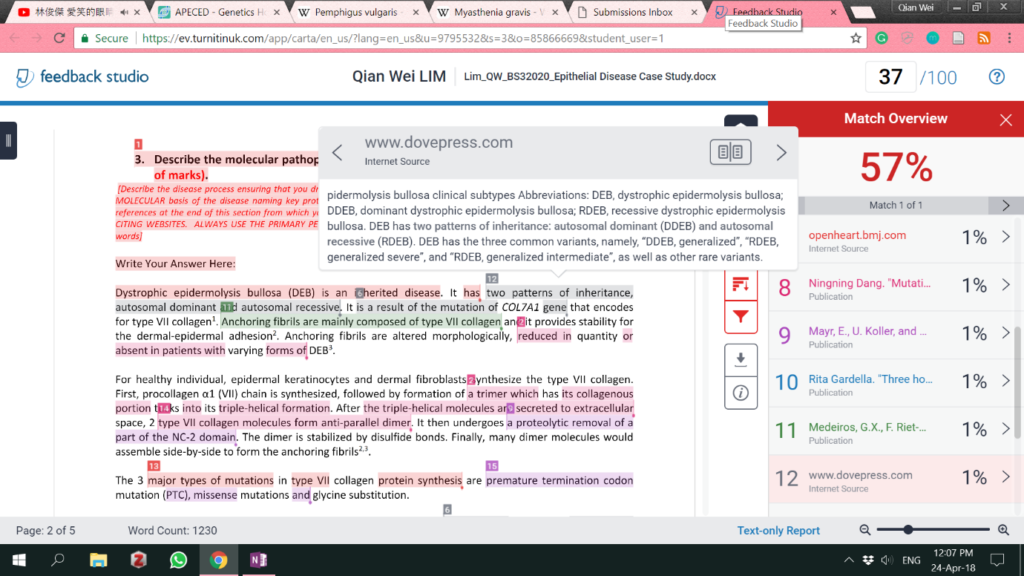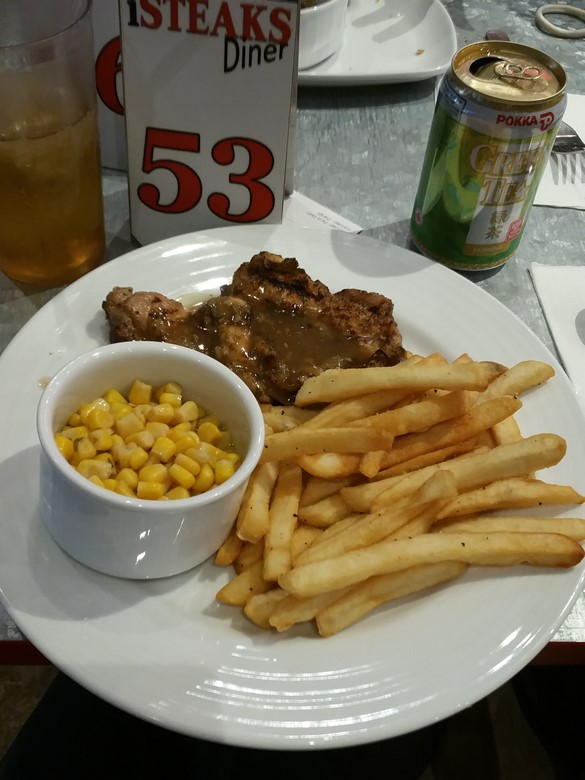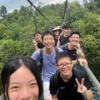Evidence that I did not plagiarize:

Dystrophic epidermolysis bullosa (DEB) is an inherited disease. It has two patterns of inheritance, autosomal dominant and autosomal recessive. It is a result of the mutation of COL7A1 gene that encodes for type VII collagen1.
My first 3 sentences are based on Dang et al, 2008. “Dystrophic epidermolysis bullosa (DEB) is inherited in both an autosomal dominant DEB and autosomal recessive manner RDEB, both of which result from mutations in the type VII collagen gene (COL7A1).”
Anchoring fibrils are mainly composed of type VII collagen and it provides stability for the dermal-epidermal adhesion2.
It was flagged against a source that I had never read before. The information came from Shinkuma, 2015. “Type VII collagen is a major component of the anchoring fibril located below the basement membrane in the upper dermis, providing stable dermal–epidermal adhesion.”
Anchoring fibrils are altered morphologically, reduced in quantity or absent in patients with varying forms of DEB3.
How else could I phrase this sentence? This is a fact that cannot be altered. I got the information from Chung et al, 2010. “At the same time, anchoring fibrils were shown by ultrastructural analysis to be morphologically altered, reduced in number, or completely absent in patients with different forms of DEB.”
For healthy individual, epidermal keratinocytes and dermal fibroblasts synthesize the type VII collagen. First, procollagen α1 (VII) chain is synthesized, followed by formation of a trimer which has its collagenous portion tucks into its triple-helical formation. After the triple-helical molecules are secreted to extracellular space, 2 type VII collagen molecules form anti-parallel dimer. It then undergoes a proteolytic removal of a part of the NC-2 domain. The dimer is stabilized by disulfide bonds. Finally, many dimer molecules would assemble side-by-side to form the anchoring fibrils2,3.
As seen from my in text citation, the information was from Shinkuma, 2015 and Chung et al, 2010.
Shinkuma: “Type VII collagen is synthesized both by epidermal keratinocytes and dermal fibroblasts. Upon synthesis of a complete procollagen α1 (VII) chain, three polypeptides associate through their carboxyl-terminal ends to form a trimer whose collagenous portion folds into the triple-helical formation. The triple-helical molecules are then secreted to the extracellular milieu where two type VII collagen molecules align into a tail-to-tail antiparallel dimer. A portion of the NC-2 domain is removed, and the association of the homotrimers is stabilized by intermolecular disulfide bond formation in the overlapping carboxyl-terminal regions. Subsequently, a large number of these antiparallel dimers aggregate laterally to form anchoring fibrils.”
Chung et al: “Type VII collagen is synthesized both by epidermal keratinocytes and dermal fibroblasts in
culture (Fig. 4) [18]. Upon synthesis of complete pro-α1(VII) polypeptides, three polypeptides associate through their carboxy-terminal ends to a trimer molecule which in its collagenous portion folds into the triple-helical formation (Fig. 3). The triple-helical molecules are then secreted to the extracellular milieu where two type VII collagen molecules align into an antiparallel dimer with the amino-terminal domains present at both ends of the molecule (Figs. 1b, c and 3) [5]. This dimer assembly is accompanied by proteolytic removal of a portion of the carboxy-terminal end of both type VII collagen molecules and stabilization by inter-molecular disulfide bond formation (Fig. 3) [19]. Subsequently, a large number of these anti-parallel dimers aggregate laterally to form anchoring fibrils that can be recognized by transmission electron microscopy of the skin through their characteristic, centro-symmetric banding patterns.”
The 3 major types of mutations in type VII collagen protein synthesis are premature termination codon mutation (PTC), missense mutations and glycine substitution.
This is literally a ‘signpost’ to act as an introduction to my next 3 points. And it got flagged out as plagiarism. Sure, dystrophic epidermolysis bullosa is a very specialized topic, and anyone else who had written on it probably would have written something similar before, but flagging a simple sentence that I used as a ‘signpost’ is really wrong.
PTC mutations that arise from mutation of COL7A1 gene will result in the formation of truncated polypeptides which are non-functional and cannot assemble into anchoring fibril. This leads to Hallopeau-Siemens variant of recessive dystrophic epidermolysis bullosa (HS-RDEB)1.
I was flagged for plagiarising the name of a disease. There was no way I could have changed the name of the disease.
Most mutations found near exon 73 in the triple helix of COL7A1 are the cause of dominant DEB, while mutation in other areas has lesser dominant interference1.
It was flagged against the cited source (Dang et al, 2008), and it wasn’t like I copied the sentence off the article or anything.
According to plagiarism.org
All of the following are considered plagiarism:
- turning in someone else’s work as your own
- copying words or ideas from someone else without giving credit
- failing to put a quotation in quotation marks
- giving incorrect information about the source of a quotation
- changing words but copying the sentence structure of a source without giving credit
- copying so many words or ideas from a source that it makes up the majority of your work, whether you give credit or not (see our section on “fair use” rules)
I do not think I had committed any of it. I do not think I had plagiarized. I do not deserve the bad grade. I do not deserve to be accused like this.
Page 1
Just to add on, while I was meeting my Professor regarding this issue, while he was scrolling through the list to find my assignment, I actually saw someone scoring 95/100 with 11% plagiarism rate. How is this even possible, when everyone else has a minimum of 30+% due to using the same assignment template?
Also, just because I am Asian doesn’t mean that English is not my first language. Stop trying to push the blame to my poor English language. Sure, language is never my forte, hell it might even be below average, but assuming English is not my first language just because I am Asian is rude. I won’t name who said that, but I can say that more than one person said it straight in my face.








Stay strong!